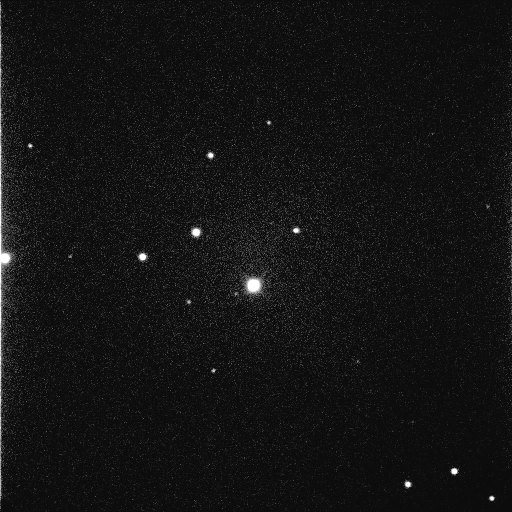
Credit & Copyright: Jim Young, Table Mountain Facility, JPL
When Karl Reinmuth discovered asteroid 1937 UB on October 28, 1937, at the Königstuhl near Heidelberg, Germany, the asteroid approached the Earth to less than two lunar distances, moving across the sky at 20' per hour. Although the object was lost shortly after discovery, it was named "Hermes", after the messenger of the gods, due to it's "uncommon character". Thus, 1937 UB was (and still is) the only minor planet that has a name, but no permanent number assigned to it. And it was (but no longer is) the most famous "lost" asteroid.
Hermes was receovered incidentally by the LONEOS survey during routine operation on October 15, 2003. Jim Young, working at the 0.6m f/16 reflector at Table Mountain confirmed the object within the same night. With the positions from LONEOS and Table Mountain, Tim Sphar and Andrea Boattini quickly realized that the "new" object is long-lost Hermes, and the recovery was announced less than eight hours after LONEOS images were taken.

The sequence above shows the motion of Hermes during the five minutes covered by the three images taken by Jim Young on Octobr 15. As the telescope was tracking the asteroid, Hermes seem so be fixed near the center of the images in this short animation, while the stars slowly drift in the background. Each of the images, 9' square, is a 60 second exposure with a 1k x 1k CCD camera at the 0.6m f/16 reflector at Table Mountain.
Astrometrica was not only used by Young to measure the precise position of Hermes on the images shown above, but also by Reiner Stoss to identify a single 2002 pre-recovery observation on a set of three stacked images from the NEAT archive, and by Rob McNaught to measure a pre-recovery position form images that he took with the 1m reflector at Siding Spring during a targeted campaign to recover Hermes in 2001. Ufortunately, the faint image of Hermes was overlooked at that time.
Related Links: